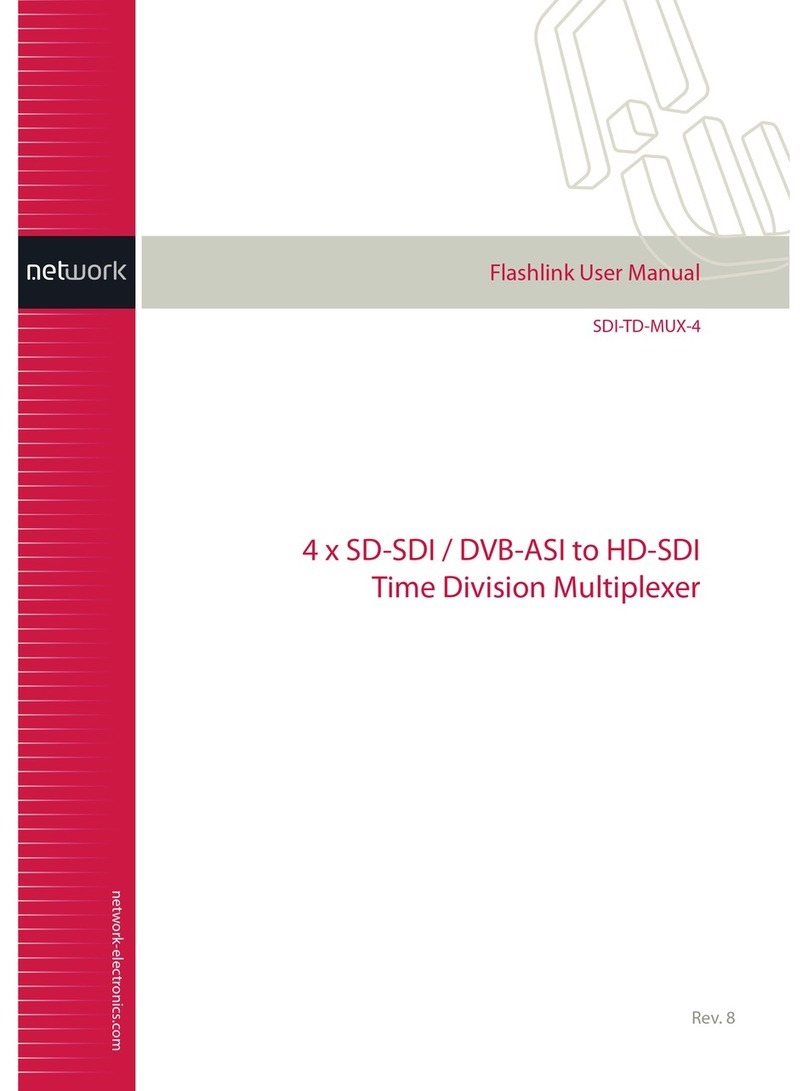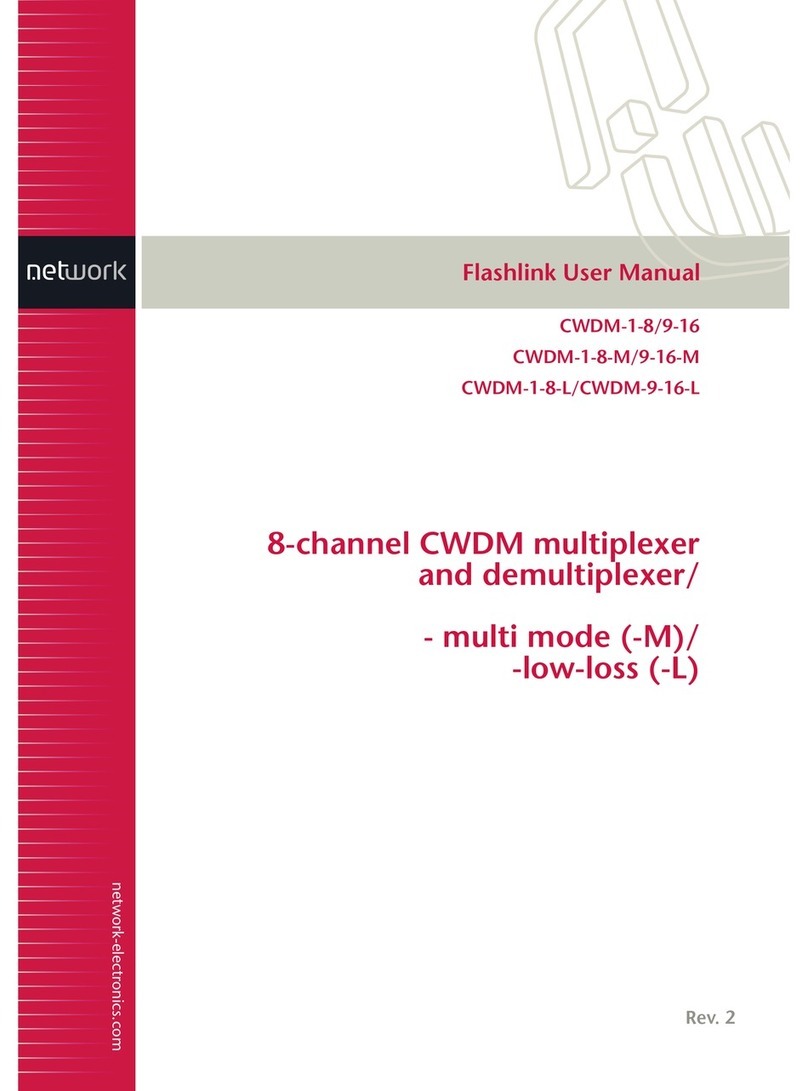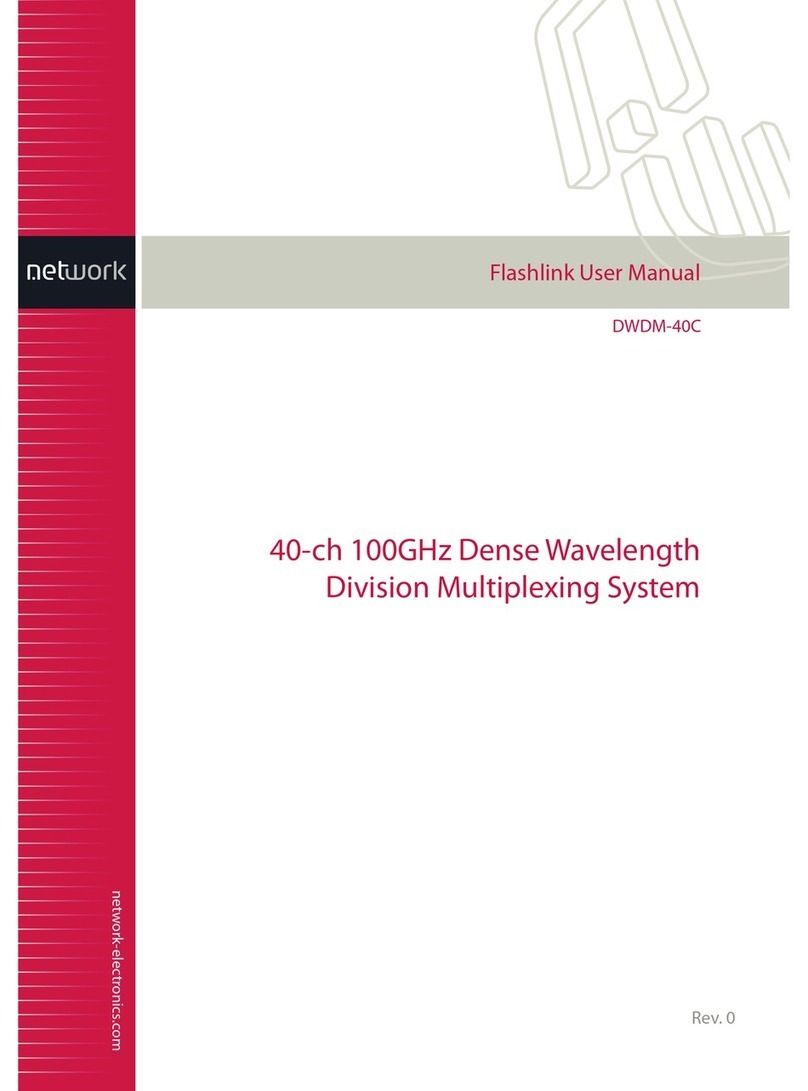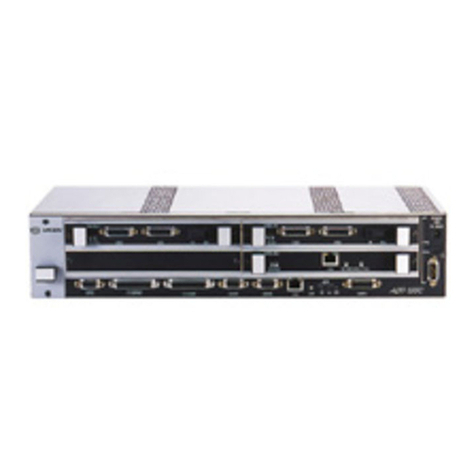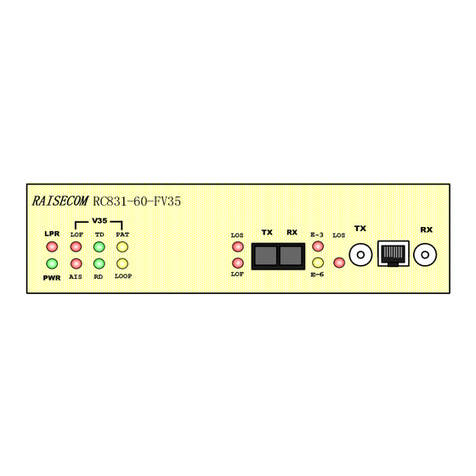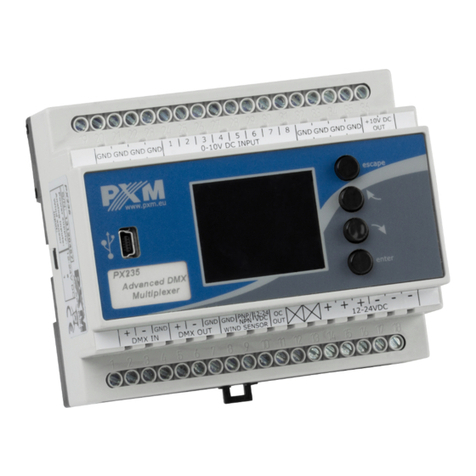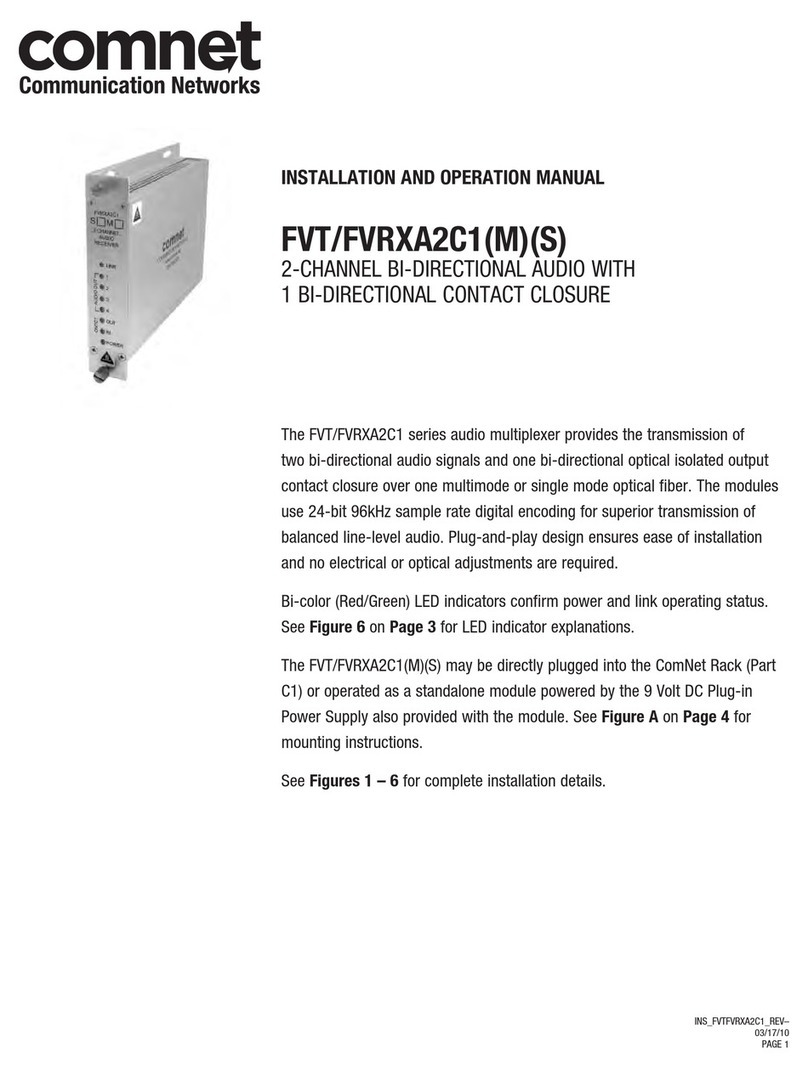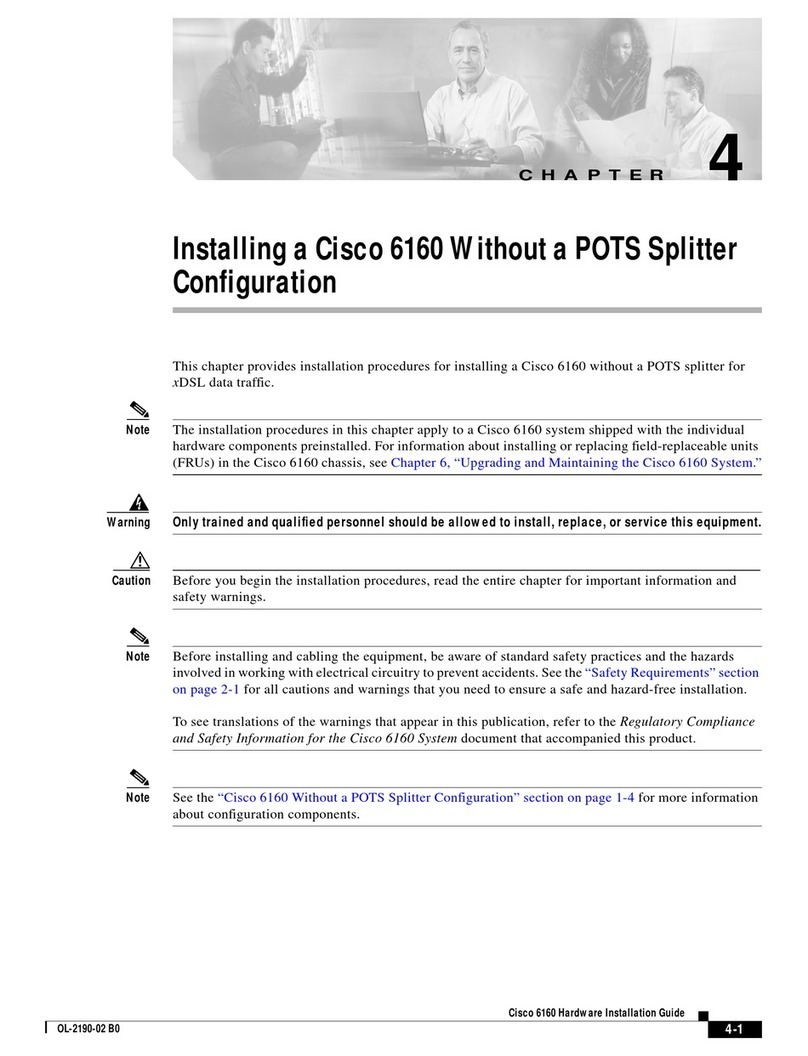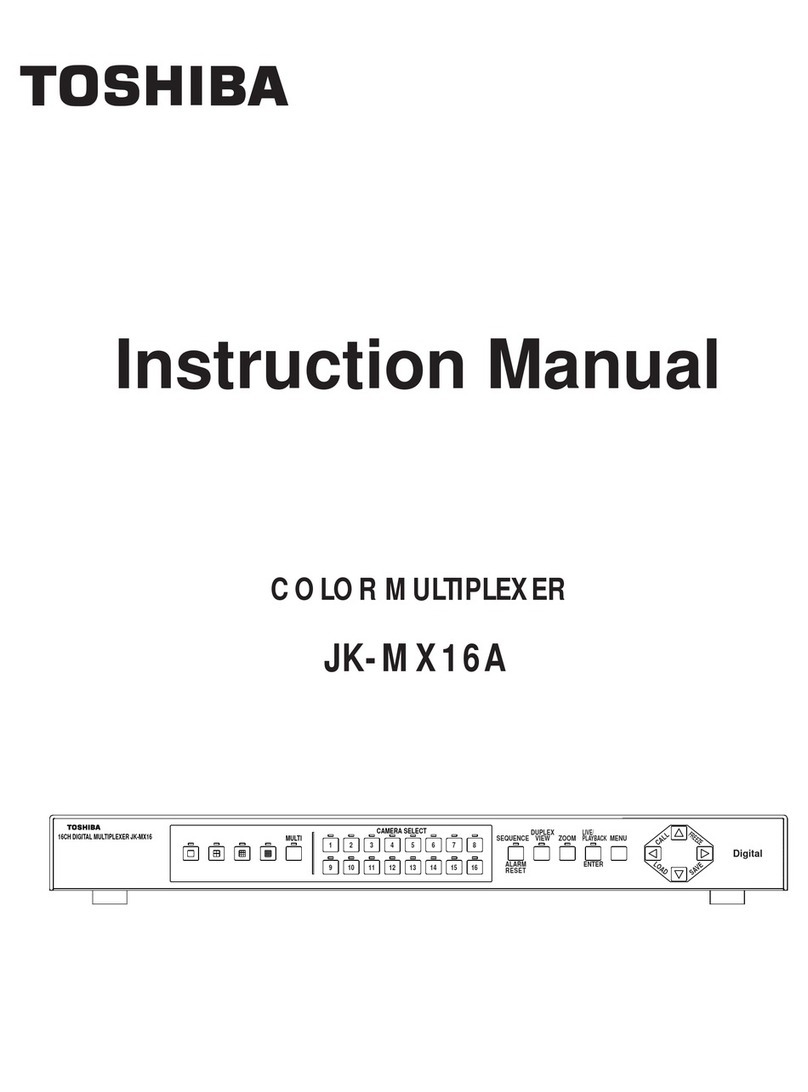Network Electronics SDI-TD-DMUX-4 User manual

network-electronics.com
HD-SDI to 4 x SD-SDI / DVB-ASI
Time Division Demultiplexer
Rev. 5
Flashlink User Manual
SDI-TD-DMUX-4

SDI-TD-DMUX-4 Rev. 5
Network Electronics ASA
Thorøya
P.O. Box 1020
N-3204 Sandefjord, Norway
Phone: +47 33 48 99 99
Fax: +47 33 48 99 98
Email: [email protected]
www.network-electronics.com
Support Phone: +47 90 60 99 99
Revision history
Current revision of this document is the uppermost in the table below.
Revision Replaces Date Change description
5 4 2007-10-08 Added Materials Declaration and EFUP
4 3 2007-06-22 Added new input select mode
3 2 2007-05-11 Added RSSI and signal generator info (chapter 4).
2 1 2007-01-02 Moved Specifications to chapter 2.
1 0 2006-11-21 New DIP-switch functionality. GYDA renamed to
GYDA-SC. New LED function on lost HD signal. Can
run on a single 5V supply too.
0 - 2006-09-21 Initial revision
network-electronics.com | 2

SDI-TD-DMUX-4 Rev. 5
Contents
Revision history ......................................................................................2
1 Product overview ................................................................................4
1.1 Main features.......................................................................................................4
1.2 Front view ...........................................................................................................5
1.3 Rear view .............................................................................................................6
1.4 Power connection................................................................................................7
1.5 Product Variants ..................................................................................................7
2 Specifications ......................................................................................8
3 Configuration......................................................................................9
3.1 Newer boards (FW rev 2.0 and later) ...................................................................9
3.2 Older boards (FW rev 1.x and 0.x).....................................................................12
4 Operation .........................................................................................14
5 Front Panel LEDs ...............................................................................15
6 GPI alarms.........................................................................................16
6.1 GPI/ Data connections RJ45 ...............................................................................16
7 GYDA-SC Interface ............................................................................17
8 Laser safety precautions ....................................................................18
General environmental requirements for Network Electronics equipment
............................................................................................................19
Certificate of Conformity......................................................................20
Product Warranty.................................................................................21
Appendix A Materials declaration and recycling information ................22
A.1 Materials declaration .........................................................................................22
A.2 Recycling information........................................................................................22
network-electronics.com | 3

SDI-TD-DMUX-4 Rev. 5
1Product overview
The SDI-TD-DMUX-4 is a Flashlink time division de-multiplexer where four SD-SDI or DVB-
ASI input signals are regained from the HD-SDI multiplexed input signal. There are both
optical and electrical HD-SDI input options. The input signal complies with the SMPTE
346M-2000 standard. Use the SDI-TD-MUX-4 board for generating the HD-SDI signal.
1.1 Main features
−Accepts and automatically detects many SD-SDI 270 Mbps input stream formats as
well as 270 Mbps DVB-ASI, of which four streams of any mix are embedded in the
HD-SDI input signal.
−Built-in routing switcher for allocating input streams to output connectors.
−Independent input streams allow uninterrupted signal transport of remaining signals
on loss of stream data for one or more streams.
−Separate stream clock reference data for each channel is received from the
multiplexer for individual clock regeneration per channel.
−Optical or electrical 1.485 Gbps input HD-SDI signal.
−High performance optics for short and long haul applications including CWDM
option.
−The output signals will automatically be regained at same clock rate and format as on
the inputs on the multiplexer side.
−EDH handling for the SD-SDI.
−GYDA-SC interface allows remote control, status monitoring, error reporting and
SNMP support.
Figure 1: Block diagram for the SDI-TD-DMUX-4
network-electronics.com | 4

SDI-TD-DMUX-4 Rev. 5
1.2 Front view
There will be a frame front covering the board and the on-board DIP-switches are then
inaccessible (the cover can be opened). The LEDs are visible through the front panel by use
of integral optical guides in the front panel, as shown in Figure 2.
Figure 2: Front Panel View with LED Indicators (only leftmost rack position shown)
Figure 3 shows a sketch of the SDI-TD-DMUX-4 board. The front view will be towards the
left side of the board. The DIP switches and the LEDs are the only parts of interest for the
user.
DIP switches
OFF ON
’0’ ’1’
J
umper needed
for proper
operation
Optical
backplane
connector
LED
indicators
Electrical backplane
connector with signals
and power lines
Figure 3: Demux Board Layout
network-electronics.com | 5

SDI-TD-DMUX-4 Rev. 5
1.3 Rear view
The rear view of the board is towards the right side of the board, as shown in Figure 3. The
board must be mounted in a Flashlink FR-2RU-10-2 frame with a dedicated backplane board
for the SDI-TD-DMUX-4 board.
Figure 4 shows the backplane rear view. Avoid inserting the SDI-TD-DMUX-4 board into a
wrong backplane board, as this may cause electrical or mechanical damage to the board.
The SD1 to SD4 outputs are for 270 Mbps SD-SDI or DVB-ASI signals.
The HD input carries the electrical HD signal with the four input signals time division
multiplexed according to the SMPTE 346M-2000 standard.
The optical input is the same as the HD-input, but with an optical interface.
The GPI outputs are alarm signals for driving external alarm devices.
SD2 Output
HD Optical Input
SD3 Output
SD1 Output
SD4 Output
GPI Outputs
HD Electrical Input
Figure 4: Rear view showing the backplane
Note that the same backplane can be used for both the SDI-TD-MUX-4 board and the SDI-
TD-DMUX-4 board.
The following connectors are available:
Name Description Connector Type
SD1 Output for 270 Mbps SD-SDI or DVB-ASI. BNC
SD2 Output for 270 Mbps SD-SDI or DVB-ASI. BNC
SD3 Output for 270 Mbps SD-SDI or DVB-ASI. BNC
SD4 Output for 270 Mbps SD-SDI or DVB-ASI. BNC
HD Input for 1.485 Gbps HD-SDI
(Multiplex according to SMPTE 346M-2000).
BNC
OPT Optical input for 1.485 Gbps HD-SDI. SC/UPC
GPI General Purpose Interface (transistor drivers for
external alarm devices).
RJ-45
Note: There are also a number of connectors on the board itself, but none of these are
usable to the end-user. For proper operation, make sure there is a jumper in the lower
position of the connector located behind the DIP-switches (see Figure 3).
network-electronics.com | 6

SDI-TD-DMUX-4 Rev. 5
1.4 Power connection
Power is applied to the board via the backplane board, which again is plugged into the
power distribution board in the Flashlink rack.
The SDI-TD-DMUX-4 board typically consumes 3.5 watts from the +5V supply and 1.8 watts
from the +15V supply available at the backplane. This limits the number of boards in a rack
to 8 boards plus GYDA-SC, when using a standard single power supply. Always verify that
the power supply can deliver the maximum nominal power when populating a Flashlink rack
with a mix of board types.
Note that the SDI-TD-DMUX-4 can also run on a single 5V supply, but then the full power of
about 5.2 watts will be drawn from the 5V supply. The board automatically adapts to sharing
the load between +5V and +15V when 15V is available.
1.5 Product Variants
SDI-TD-DMUX-4 4-ch. SDI time division de-multiplexer, DVB-ASI compatible,
complies with SMPTE 346M-2000, ch. swap capability, built-in
emergency changeover.
SDI-TD-DMUX-4-R 4-ch. SDI time division de-multiplexer, DVB-ASI compatible,
complies with SMPTE 346M-2000, optical receiver -25dBm
sensitivity, ch. swap capability, built-in emergency changeover.
SDI-TD-DMUX-4-RM 4-Channel SDI time division de-multiplexer with multimode PIN
receiver, max. 300m fibre distance, DVB-ASI compatible, complies
with SMPTE 346M-2000, channel swap capability, built-in
emergency changeover.
network-electronics.com | 7

SDI-TD-DMUX-4 Rev. 5
2Specifications
Optical input
Input signal HD-SDI, TDM payload according to SMPTE 346M-2000
Sensitivity Better than -25dBm
Max multi mode fibre length 300m (version SDI-TD-DMUX-4-RM)
Detector overload threshold Min. -6dBm
Detector damage threshold > +1dBm
Optical wavelength 1200 - 1620nm
Transmission circuit fibre Single Mode 9/125µm or multimode 50/125µm
Connector return loss better than 40dB w/ SM fibre
Connector SC/UPC
Electrical input
Output signal HD-SDI with TDM payload according to SMPTE 346M-
2000
Data rate 1485 Mbps
Equalisation Automatic up to 100m
Impedance 75 ohm
Return loss >15dB @ 270MHz
Signal level Nom. 800mV
Connector BNC
Electrical output
Number of outputs 4 independent SD-SDI, DVB-ASI
Data rate 270 Mbps
Impedance 75 ohm
Return loss >15dB @ 270MHz
Jitter (UI = Unit Interval) Max. 0.2UI
Peak to peak signal level 0.8V ±0.1V
Signal polarity Non-inverting
Connector BNC
Electrical
Temperature range 0 to +45 °C
Power consumption +5V/3.5 W, +15V /1.8W
(5.2W when running on a single +5V supply)
Control RS-422, GYDA-SC enabled, SNMP
Latency
Electrical and optical delay Less than 100μs (combined through MUX and DEMUX) In
addition comes 5us/km of fibre signal propagation time
Standards
Supported standards for electrical and optical ports:
SMPTE SMPTE 346M-2000, SMPTE 292M, SMPTE 259M,
SMPTE 305.2M, SMPTE 297M, SMPTE RP165
DVB-ASI EN50083-9
network-electronics.com | 8

SDI-TD-DMUX-4 Rev. 5
3Configuration
The SDI-TD-DMUX-4 is self-configuring in the sense that it will start working according to
default factory settings once the input signals and power are applied. Signals will be routed
straight through without swapping and SD-SDI/DVB-ASI will be detected and handled
automatically.
There are also configuration parameters available via DIP-switches in the front of the board
and via the Flashlink-protocol commands from GYDA-SC.
There are two variants of the boards. Early versions (boards with firmware revision (FW) 1.x)
have full flexibility channel swapping and no other configuration options. Later versions
(boards with firmware revision (FW) 2.0 and later) have more functions, but less flexibility on
channel swapping.
3.1 Newer boards (FW rev 2.0 and later)
The DIP switches control the channel-to-stream allocation according to the below table. See
also Figure 5 for details on setting the switches.
Note that when GYDA-SC mode is selected, there are no limitations on how the routing is
controlled – as opposed to when operating from DIP-switches.
Switch 1 (’off’ / 0)
Switch 2 (’off’ / 0)
Switch 3 (’off’ / 0)
Switch 4 (’off’ / 0)
Switch 5 (’off’ / 0)
Switch 6 (’off’ / 0)
Switch 7 (’off’ / 0)
Switch 8
(
’off’ / 0
)
Routing
Shown: 1=>1 , 2=>2 , 3=>3 , 4=>4
Input Select
Shown: Auto, priority optical
Output Select (when no input)
Shown: black picture, auto video standard
Mode. Shown: GYDA control enabled
(Upper left corner of board)
OFF ON
1
2
3
4
5
6
7
8
Figure 5: DIP Switch Settings (see also table below)
network-electronics.com | 9

SDI-TD-DMUX-4 Rev. 5
DIP setting Description Comments
DISTRIBUTION
RRR----1
(Dashes ‘-‘ indicate
that these switches
are not related to
this function).
‘RRR’ are allowing control of distribution of one
or more input streams to one or more outputs.
000: 1=>1 2=>2 3=>3 4=>4
001: 1=>1 1=>2 3=>3 4=>4
010: 1=>1 1=>2 3=>3 3=>4
011: 1=>1 1=>2 1=>3 4=>4
1xx: 1=>1 1=>2 1=>3 1=>4
(Stream to output allocation)
‘000’ is factory
default.
See note below.
Input selection
---II--1
‘II’ are controlling which HD-input signal to
use.
00: Use optical input only
01: Use electrical input only
10: Auto, priority optical without lock control
11: Auto, priority optical with lock control
‘00’ is factory
default.
See note below.
Generator
Selection
-----OO1
‘OO’ are controlling which signal to use on the
outputs when no input signal exists.
00: Black picture, auto v.std.
01: Colour bar, auto v.std.
10: Black picture, 525 lines
11: Black picture, 625 lines
(auto v.std = automatic standard detection -
525/625 lines according to lost signal)
‘00’ is factory
default.
See note below.
Control Mode
-------D
‘D’ is controlling whether the board is
controlled by DIP-switches or from GYDA-SC.
0: GYDA-SC control
1: DIP-switch control
‘0’ is factory default.
Notes:
−Be aware that it is possible to alter the swap or distribution on the MUX-side as well.
−You may have to swap cables at the rear to get exactly the configuration you are
looking for
−The ‘OO’ setting has no effect on outputs fed with a valid signal from the HD mux-
stream. It will only have effect when no input signal is present.
−There is no on-board DVB-ASI signal generator available. When loosing a DVB-ASI
signal, the output will not carry a valid DVB-ASI signal.
On power-on, the actual settings will be according to the dip-switches, except when the
GYDA-SC control mode is selected. In that case, the last GYDA-SC setting will be restored
from on-board non-volatile memory.
In auto mode without lock control (ll=’10’), the operation is like this:
1. If there is a carrier on the optical input, always select this input.
2. If there is no carrier on the optical input, the electrical input will only be selected if it
has got a carrier.
3. There is no check for signal lock and there are no significant delays before swapping
to the other input.
In auto mode with lock control (ll=’11’), the operation is like this:
1. On power-on, the board will start with selecting the optical input as default.
network-electronics.com | 10

SDI-TD-DMUX-4 Rev. 5
2. If, at any time, the lock is lost on the presently selected input, after a one second
delay, the board will first check if there is a carrier on the other input. If it isn’t, the
input select will remain unchanged. If there is a carrier on the other input, the board
will swap to that input and try to lock to it.
3. If both inputs have a carrier, but the board is incapable of locking to any of the
signals, the board will toggle between the two inputs until a lockable signal is applied
to either of the two inputs. Then, this input will be selected. The toggling rate is
about once per second while searching for a lockable signal.
4. If none of the inputs has a carrier, the board will remain at its present input selection
(the last one it successfully locked to or tried to lock to).
5. If there is a carrier on only one of the inputs, only this input will be selected as long as
this is the case (no toggling).
6. There will always be a one second delay before giving up the presently selected signal
on loss of lock.
7. There will be no non-volatile memory for keeping the last selected input when in
auto mode. The above algorithm will always start working to find a signal when
starting the board. This means that, after power-on, the optical input will always win
if there is a lockable signal present at that input.
Other board settings available from GYDA-SC:
Control item GYDA-SC mode
DIP = ‘-------0’
Non-GYDA-SC mode
DIP = ‘-------1’
Input select GYDA-SC can select ‘electrical’, ‘optical’ or
‘auto’ modus. In ‘auto’ modus, the optical
input has priority over the electrical input.
Input select according to
DIP-switches. See above
table.
EDH counters Under GYDA-SC control (can be read and
reset from GYDA-SC).
Counting still active on the
MUX board (on errors), but
without any functional
significance.
EDH flags Can be read from GYDA-SC. Flags still operating on
board, but without any
functional significance.
EDH masks Can be changed from GYDA-SC. Not
stored in non-volatile memory, so power
on default is ‘all active’, until GYDA-SC
configures otherwise.
EDH masks remains
unchanged from last setting.
Default on power on is all
active.
Channel swap Can be controlled by GYDA-SC, all options
available.
In addition, GYDA-SC can select internal
signal generators for test and debug
purposes. Colour bar 525, colour bar 625,
black 525 or black 625 can be selected for
each SD-SDI output.
Channel swap/distribution
according to DIP-switches.
See above table.
network-electronics.com | 11

SDI-TD-DMUX-4 Rev. 5
3.2 Older boards (FW rev 1.x and 0.x)
The DIP switches control the channel-to-stream allocation according to the below table. See
also Figure 6 for details on setting the switches.
1
2
3
4
5
6
7
8
Switch 1 (’on’ / 0)
Switch 2 (’on’ / 0)
Switch 3 (’on’ / 0)
Switch 4 (’off’ / 1)
Switch 5 (’off’ / 1)
Switch 6 (’on’ / 0)
Switch 7 (’off’ / 1)
Switch 8
(
’off’ / 1
)
Output 1 (here: from SD stream 1)
Output 2 (here: from SD stream 2)
Output 3 (here: from SD stream 3)
Output 4 (here: from SD stream 4)
(Upper left corner of board)
Figure 6: DIP Switch Settings (here: no swap; see example 1 in the below table)
DIP setting Description Comments
aaxxxxxx aa tells which of the four input streams that
are allocated to output 1.
00: Input stream 1
01: Input stream 2
10: Input stream 3
11: Input stream 4
See Figure 6 to
understand how the bit-
patterns are set.
xxbbxxxx
xxxxccxx
xxxxxxdd
bb, cc and dd are similar as for aa, but for
outputs 2, 3 and 4 respectively.
Example 1:
00011011
Input stream 1 to output 1.
Input stream 2 to output 2.
Input stream 3 to output 3.
Input stream 4 to output 4.
No channel swapping.
See note below.
Example 2:
00110110
Input stream 1 to output 1.
Input stream 4 to output 2.
Input stream 2 to output 3.
Input stream 3 to output 4.
Example 3:
00001111
Input stream 1 to output 1.
Input stream 1 to output 2.
Input stream 4 to output 3.
Input stream 4 to output 4.
Example 4:
11111111
Input stream 4 to output 1.
Input stream 4 to output 2.
Input stream 4 to output 3.
Input stream 4 to output 4.
See note below.
Note:
The special setting in example 4 above serves dual purposes:
−Allocate inputs to output streams according to the above description.
−Allow GYDA commands to override DIP-setting.
This means that after DIP-switches are changed from any setting to the 11111111 setting,
network-electronics.com | 12

SDI-TD-DMUX-4 Rev. 5
the above allocations gets active, BUT at the same time allowing GYDA to send commands
with any other input stream-to-output allocation. So, when this setting is applied to the DIP-
switches, the actual configuration depends on GYDA commands.
On power-on, the actual swap setting will be according to the dip-switches, except that
when set as in Example 4, the last GYDA command will still be active
The factory default setting will be as in example 4, with last GYDA command stored in non-
volatile memory as in example 1. This means that the default start-up is “no channel
swapping”.
All other DIP switch settings are however ‘safe’ in the sense that GYDA cannot override these
settings.
Other board settings available from GYDA:
Control item GYDA mode
(DIP-sw. = ‘11111111’)
Non-GYDA mode
(any other DIP-setting)
Input select GYDA can select ‘electrical’, ‘optical’ or ‘auto’
modus. In ‘auto’ modus, the optical input has
priority over the electrical input. There are two
auto-modus setting, one with signal lock
control and one without.
‘Auto’-modus only. In
‘auto’ modus, the optical
input has priority over
the electrical input.
EDH counters Under GYDA control (can be read and reset
from GYDA).
Counting still active on
the MUX board (on
errors), but without any
functional significance.
EDH flags Can be read from GYDA. Flags still operating on
board, but without any
functional significance.
EDH masks Can be changed from GYDA. Not stored in
non-volatile memory, so power on default is ‘all
active’, until GYDA configures otherwise.
EDH masks remains
unchanged from last
setting. Default on
power on is all active.
Channel swap Can be controlled by GYDA, as shown in above
table.
In addition, GYDA can select internal signal
generators for test and debug purposes. Colour
bar 525, colour bar 625, black 525 or black
625 can be selected for each SD-SDI output.
Channel swap according
to DIP-switches. See
above table.
network-electronics.com | 13

SDI-TD-DMUX-4 Rev. 5
4Operation
The SDI-TD-DMUX-4 board receives any combination of four 270 Mbps time division
multiplexed SD-SDI or DVB-ASI signals embedded in a 1.485 Mbps HD signal via an optical
or electrical HD interface according to SMPTE 346M-2000. An SDI-TD-MUX-4 board is
required to generate this HD-signal, normally at a remote location and linked via an optical
fibre or an electrical coax cable.
Channel swapping is available either from DIP-switches or remotely via the standard GYDA-
SC interface. All outputs can be either 270 Mbps SD-SDI or DVB-ASI (188 or 204 word
packets).
The SD-SDI clocks for each channel will be regenerated based on a frequently received SCR
counter (stream clock reference – refer to the SMPTE 346M-2000 standard). This ensures a
stable, low-jitter output.
There are four signal generators on the board. Each can be set to colour bar 525, colour bar
625, black 525 or black 625 from GYDA-SC. Since the SDI-TD-DMUX-4 does not have a local
clock reference input, a valid SD signal must be present in the HD stream from the SDI-TD-
MUX-4 (i.e. at least one SD signal must be connected to one of the SDI-TD-MUX-4 SD
inputs) in order to guarantee that the output signals from the test signal generators in the
SDI-TD-DMUX-4 are compliant with the SD clock requirements.
The signal generator will by default automatically connect to the output with a black signal
whenever the corresponding input stream is lost (when no signal available in the stream
from the SDI-TD-MUX-4 board). The format (525 vs. 625 lines) will be selected automatically
to follow the signal that was lost.
There are also two alternatives to this default behaviour for the signal generators. You can
overrun this by using the DIP-switches on the board (see section 3.1) or you can turn off the
output signal automatically on loss of input stream by setting this from GYDA-SC. If you
need this feature and your revision of GYDA-SC does not support this, ask Network
Electronics for support on this matter (this is a late feature added in May 2007).
The board measures the RSSI (Received Signal Strength Indicator) from the optical input.
Normally, the readout (in the GYDA-SC GUI) shows the signal strength to within +/-1-2dB.
However, the measurement is NOT calibrated to this accuracy and the readout should be
used as an indication only. Also be aware that the readout is fairly linear within a range from
-15dB to -30dB. Outside this range, the readout will show a fixed value not representative of
the actual signal level. So, when showing a signal level of -15dB or more or a signal level of -
30dB or less, then ignore the readout – just know that the signal is either strong enough
with good margins or too weak to be detectable.
network-electronics.com | 14

SDI-TD-DMUX-4 Rev. 5
5Front Panel LEDs
Figure 7 shows how the LEDs are located on the front panel.
Figure 7: Front Panel View with LED Indicators
The table below shows how the front panel LEDs are to be interpreted.
Note that the term “in error” in the table means that there is either a missing signal (data in
transport stream) AND/OR the re-clocker has not been able to lock to the received signal.
The term “operating normally” means that a signal has been detected (data available in the
transport stream) AND the re-clocker has been able to lock to the signal.
The term “Input failure” means that there is either a missing signal (no carrier detect)
AND/OR the re-clocker has not been able to lock to the incoming signal.
Diode Description Red LED Orange LED Green LED No light
1 Card Status Power on, FPGA
not configured
Not
applicable
Power on and
FPGA
configured
Board not
powered
2 SD OUT 1
and
SD OUT 2
(see note below)
Both channels
(1 and 2)
in error
One of the
channels
(1 or 2)
in error
Both channels
(1 and 2)
operating
normally
Not
applicable
3 SD OUT 3
and
SD OUT 4
(see note below)
Both channels
(3 and 4)
in error
One of the
channels
(3 or 4)
in error
Both channels
(3 and 4)
operating
normally
Not
applicable
4 HD IN
(see note below)
Input failure Not
applicable
Input OK Not
applicable
Note: When the HD IN led is red due to a missing or corrupt HD input signal, diode 2 and 3
will automatically turn red too, even if a generator signal is available on the output.
network-electronics.com | 15

SDI-TD-DMUX-4 Rev. 5
6GPI alarms
Four alarms are present on the RJ45 connector. These four GPI signals indicate the same
status as the LEDs (see above):
−GPI0: On => Power on, FPGA not configured
Off => Power on, FPGA configured
−GPI1: On => One of the channels (1 or 2) in error
Off => Both channels (1 and 2) are OK
−GPI2: On => One of the channels (3 or 4) in error
Off => Both channels (3 and 4) are OK
−GPI3: On => No input signal *)
Off => Locked to electrical or optical input signal
*) When optical input is selected by GYDA-SC, alarm status is indicated only for optical input.
When electrical input is selected from GYDA-SC, status is indicated only for electrical input.
When GYDA-SC control is disabled or auto-select is chosen from GYDA-SC, an alarm will be
indicated only when both signals are lost.
An active alarm condition (on) means that the driver transistor is conducting to ground. The
power present alarm should always be active during normal operation.
6.1 GPI/ Data connections RJ45
The below table show the signals available on the GPI connector on the backplane.
Figure 8: RJ45 Connector for GPI Signals
RJ45 Pin Number Description
8 GND
7 Not Used
6 Not Used
5 Not Used
4 GPI3
3 GPI2
2 GPI1
1 GPI0
network-electronics.com | 16

SDI-TD-DMUX-4 Rev. 5
7GYDA-SC Interface
Figure 9 shows how GYDA-SC will present a rack equipped with an SDI-TD-MUX-4 module
in rack position 2, an SDI-TD-DMUX-4 module in rack position 6, a GYDA-SC module in rack
position 9 and power supply units in rack positions 10 and 11. For details on the GYDA-SC
graphical user interface or the communication protocol, refer to the GYDA-SC
Figure 9: GYDA-SC presentation of rack with a SDI-TD-DMUX-4 module in position 6
network-electronics.com | 17

SDI-TD-DMUX-4 Rev. 5
8Laser safety precautions
These are guidelines to limit hazards from laser exposure.
All the available EO (including ETH100) units in the Flashlink range include a laser.
Therefore this note on laser safety should be read thoroughly.
The lasers emit light at wavelengths from 1270nm up to 1610nm. This means that the
human eye cannot see the beam, and the blink reflex cannot protect the eye. (The human
eye can see light between 400 nm to 700 nm).
A laser beam can be harmful to the human eye (depending on laser power and exposure
time). Therefore:
Be careful when connecting / disconnecting fibre pigtails (ends).
Never look directly into the pigtail of the laser/fibre.
Never use microscopes, magnifying glasses or eye loupes to look into a fibre end.
Use laser safety goggles blocking light at 1310 nm and at 1550 nm
Instruments exist to verify light output power: Power meters, IR-cards etc.
Flashlink features:
All the laser module cards in the Flashlink product range, are Class 1 laser products according
to IEC 825-1 1993, and class I according to 21 CFR 1040.10 when used in normal operation.
More details can be found in the user manual for the FR-2RU-10-2 frame.
Maximum output power1: 5 mW
Operating wavelengths: > 1270 nm
1Max power is for safety analysis only and does not represent device performance.
network-electronics.com | 18

SDI-TD-DMUX-4 Rev. 5
General environmental requirements for Network Electronics
equipment
1. The equipment will meet the guaranteed performance specification under the
following environmental conditions:
- Operating room temperature range: 0°C to 45°C
- Operating relative humidity range: up to 90% (non-condensing)
2. The equipment will operate without damage under the following environmental
conditions:
- Temperature range: -10°C to 55°C
- Relative humidity range: up to 95% (non-condensing)
3. Electromagnetic compatibility conditions:
- Emissions: EN 55103-1 (Directive 89/336/EEC)
- Immunity: EN 55103-2 (Directive 89/336/EEC)
- Electrical safety: EN 60950
network-electronics.com | 19

SDI-TD-DMUX-4 Rev. 5
Certificate of Conformity
Network Electronics ASA
N-3204 Sandefjord
Norway
Company Registration Number:
NO 976 584 201 MVA
Declares under sole responsibility that the product:
Product name: SDI-TD-DMUX-4
Product description: TDM Demultiplexer (HD, according to
SMPTE 346M-2000, to 4 x SD-SDI).
To which this declaration relates are of Norwegian origin and are in conformity with the
following standards:
EN 55103-1: 1996 Generic Emissions Standard
EN 55103-2: 1996 Generic Immunity Standard
IEC 60950, 2nd Ed, 1991 + Amd. 1, 1992 +
Amd. 2, 1993 + Amd. 3, 1995 + Amd. 4, 1996
Safety Standard
network-electronics.com | 20
Table of contents
Other Network Electronics Multiplexer manuals
